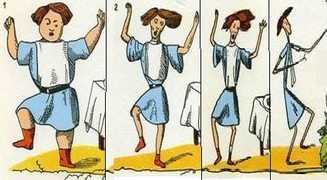|
"Just listen and observe. Follow the story, don't focus on every single word. Make sure your ears and eyes are with me. Relax and enjoy." This is my set up to story listening. This powerful method to deliver CI, has been developed and tested out extensively by Beniko Mason. I first saw her demonstrate what she does in Agen, France last summer. I was really intrigued, but also confused about where to start and nervous about being able to make sure it's comprehensible AND enjoyable to my students. And then, I just leaped, searching and prepping stories to my students' level. But before I talk about all the things I like about it, here is a simple description of what it is that I recently posted on Ben Slavic's PLC: The method is rather simple. You simplify a story so that you know your students should be able to understand it. Then you tell the story to the students and as you’re telling it you draw on the board what is happening, some key words and figures. You also add writing so that they can see the words they need. They are written in L2, sometimes in L1 underneath, but then you wipe away L1 to not cause interference.
The student’s’ job is to follow the story as a whole. It is NOT to teach anything to mastery. The goal is to tell the story so the students can understand and follow the major events and details. You can follow this up with reading the story or activities but you don’t have to.  The first story I told my classes was "Die Bremer Stadtmusikanten." Quite a long story to use as your starting point. I didn't realize how long it would take. I just liked the story, knew there were a lot of natural repetitions in it and it could be easily drawn. I thought the kids would like it because it is a little silly and a little dramatic and overall a good mix. It took over 40 minutes to tell. THAT was my starting story. Now, if I had planned this better *hu-hum* I would have started with a shorter story (I really had no clue it would take soooo long). If I had planned it better, I might have gone for a 10 minute story to ease them in. But here is the thing: It worked. It was successful despite my complete and utter misjudgement on how long it would take me to tell this story. My first graders (!) followed and understood the story, so did my third graders as well as my beginners in 7th and 8th grade. What I found most baffling was how well my ESL beginners listened. These kids have the hardest job in the whole school. They have just arrived in Germany and have to learn German and English at the same time. The bridge we try to build with giving translations in L1, is a crumbly, badly built construction for these kids. It's useless. In fact, it adds another layer of stress to kids, who are in a very stressful setting already. During story listening, I speak hardly any English, maybe a word, maybe two, mostly none. I translate some words on the board, but a lot is explained through the drawings and the gestures and my mimic as I tell the story to them. This method has brought smiles to the kids, who are used to not understanding. It has allowed them to relax. To enjoy the story, not focus on every single word. Beniko Mason, who is a German learner herself, has watched my videos and after the first one, she wrote to me: "You have Japanese kids in your class. I can hear them talking about the story, they are saying the Japanese words for 'cat' and 'dog' when you tell the story." This feedback is amazing to me, because I don't understand Japanese and when they talk to each other, you often wonder, are they talking about lunch or are they following? Add to my specific circumstance the layer of being completely aware how overwhelming this class must be when you already don't understand much all day.  I had one student, who had a rough start this year and has been really overwhelmed by everything being different and new, who said after I told "Der Suppenkasper" and then read it together in class: "Frau Shechtman, I understood all!" His whole face lit up when he said it, he was so proud. In another class, the students are very active and they always comment on what is happening, but they are doing so - most of the time - in German. Complete unforced verbal output. During "Der süße Brei" the students used words from the St. Martin's tale (Bettler) and other repeating phrases (Eines Tages...) to add to the story or make predictions about what is coming next. It's beautiful. I see students from 2nd grade up that are able to draw a scene from the story and skim the reading for the one or maybe two sentences that match the picture to copy it underneath. That is an incredible skill, especially for young kids. I have fallen in love with this for the effect it has on my ESL students, for the richness of input for all of my students. For the drawing and dramatics that I get to play with (Fact: I love acting and my first degree is in Graphic Design, but fear not, both are not prerequisites). For the excitement I see. For the low stress for both me and my students. For searching and finding all these great stories with all their happy and unhappy endings, that make us laugh, ponder or just say "What? That was so weird!" This school year has been the year of trying things. If I think it's interesting and will work well, I will try it. That has brought me a lot of enjoyment this year. First with the Invisibles (Ben Slavic) and now with Story Listening (Beniko Mason). I had almost gone to complete PQA before this because the repetition of vocabulary happens so much more natural in that than in the stories. I see now that this is the biggest change this year: I am not teaching for mastery of any given phrase, I am teaching for quality and richness of input. And the best thing? Every kid takes what they can handle and need at that moment from that particular story. There is something for everyone. Differentiation in both directions is a given here and if we're honest, don't most of us differentiate down, but not up? This has also inspired my comprehension checks, which I will post here as well. I am always inspired by Claire Walter as well, so she had some influence on this and I am using one of her rubrics to rate the work of my students. Story listening has been an enrichment to my classroom and I am thankful I jumped in and tried it. It's love y'all!
2 Comments
Beniko
16/12/2016 05:37:25
Listen, breath and observe. I like that!
Reply
Jeanette Borich
17/12/2016 08:02:34
Thank you for this awesome posting. Excellent reflection regarding SL for every student--the potential for differentiation--"Every kid takes what they can handle."
Reply
Your comment will be posted after it is approved.
Leave a Reply. |
If you like my videos and materials, consider buying me a coffee. :)
Archives
May 2022
Categories
All
|
||||||

 RSS Feed
RSS Feed
